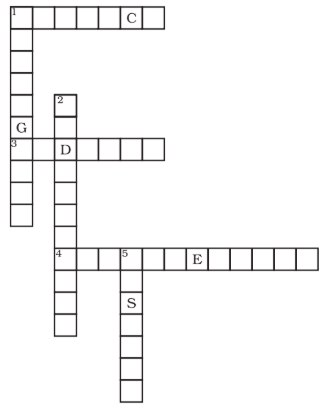NEET/JEE Coaching Scholarship
ApplyGet up to 90% Scholarship on Offline NEET/JEE coaching from top Institutes
According to CBSE Syllabus 2025-26, this chapter has been renumbered as Chapter 5.
NCERT Solutions for Class 8 Science Chapter 5 Conservation of Plants and Animals: To conserve plant and animals is important in maintaining ecological balance and biodiversity. This chapter helps students understand the importance of the harmful effects of deforestation and various conservation methods. It also introduces key concepts such as wildlife, sanctuaries, national parks, biosphere reserves, and the role of reforestation and restoring natural habitats. Students can build a strong conceptual foundation by referring to these explanations. For finding solutions to any other class questions, NCERT Solutions will help you out.

For a quick revision, the Conservation of Plants and Animals Class 8 questions and answers section helps students read the chapter efficiently. The NCERT Solutions for Class 8 are written in simple language to improve concept clarity. Additionally, students can download the solutions in PDF format to study in their comfort. Since these solutions are similar to the latest CBSE syllabus, they prove a reliable resource for students aiming to score high in exams.
Download the complete PDF containing clear and accurate solutions to all the questions from this chapter to help you study and revise more effectively.
(a) A place where animals are protected in their natural habitat is called_________.
(b) Species found only in a particular area is known as_________.
(c) Migratory birds fly to faraway places because of_________changes.
Answer:
(a) A place where animals are protected in their natural habitat is called a Sanctuary.
(b) Species found only in a particular area are known as endemic species.
(c) Migratory birds fly to faraway places because of climate changes.
Q2 (a). Differentiate between the following.
Wildlife sanctuary and biosphere reserve
Answer:
Here is the difference between a wildlife sanctuary and a biosphere reserve:
| Wildlife sanctuary | Biosphere reserve |
| 1. It is a place where animals are protected from any disturbance and also their habitat is conserved. 2. It provides protection as well as suitable living conditions for wild animals. 3. example- Bori and Pachmarhi (part of Pachmarhi biosphere) | 1. It is a large area of protected land for the conservation of animals, plants and their habitat. 2. It helps to maintain the biodiversity and culture of that area. 3. ex. Pachmarhi biosphere |
Q2 (b). Differentiate between the following.
Zoo and wildlife sanctuary
Answer:
Here is the difference between a zoo and a wildlife sanctuary:
| Wildlife sanctuary | Zoo |
| 1. It is a place where animals are protected from any disturbance and also their habitat is conserved. 2. It provides protection as well as suitable living conditions for wild animals. | 1. It is a place where animals are kept for public exhibitions 2. It is an artificial habitat, where things are provided by humans/owners |
Q2 (c). Differentiate between the following.
Endangered and extinct species
Answer:
Here is the difference between endangered and extinct species:
| Endangered Species | Extinct species |
| 1. The species which are going to be extinct or on the verge of becoming extinct. 2. ex- a blue whale | 1. Those species which are already gone or no longer exist on earth. 2. ex- dodo |
Q2 (d). Differentiate between the following.
Flora and fauna
Answer:
Here is the difference between flora and fauna:
| Flora | Fauna |
| 1. These are living plants from a particular area. 2. Sal, teak, jamun and Silver ferns are examples of flora. | 1. animals living in a particular area 2. barking deer, wolf, cheetah, and wild dog are examples of fauna. |
Q3. Discuss the effects of deforestation on the following.
(a) Wild animal
Answer: Due to deforestation, the forests are going to be exterminated and because of that animals are losing their homes as well as their natural habitat. Therefore their populations are going down rapidly.
Q3. Discuss the effects of deforestation on the following.
(b) Environment
Answer: Due to deforestation, unbalancing is happen between carbon dioxide and oxygen. Also, it affects the climate of the surrounding environment. Global warming is increasing because of the increase in the amount of carbon dioxide.
Q3. Discuss the effects of deforestation on the following
(c) Villages (Rural areas)
Answer- Because of deforestation, in rural areas, the level of groundwater goes down which means access to potable water becomes difficult. Also, more chance of soil erosion is occurring because plant roots that hold the soil particles together have been removed also the fertility of the soil is decreased.
Q3. Discuss the effects of deforestation on the following.
(d) Cities (Urban areas)
Answer:- Effects of deforestation on cities:
It can increase the chances of natural calamities like a flood or heavy rainfall. Also, it can lead to global warming because of the increase in the level of carbon dioxide in the atmosphere because of vehicular and industrial pollution. An increase in temperature also disturbs the water cycle.
Q3. Discuss the effects of deforestation on the following.
(e) Earth
Answer:
Deforestation disturbs the whole ecological system. As a result of deforestation, an increase in chances of floods, soil erosion, drought, and desertification increase. Also, increase global warming due to the increase in the level of carbon dioxide. As a result, the total water cycle gets disturbed and also the level of potable water goes down.
Q3. Discuss the effects of deforestation on the following.
(f) The next generation
Answer:
Effect of deforestation on the next generation- Deforestation causes many problems such as drought, floods, soil erosion, greenhouse effects, and other global issues, etc. And after all, the consequences of these will affect the future generation.
(a) we go on cutting tree
(a) we go on cutting trees
Answer: If we cut the trees, the life of animals and their habitat will completely vanish.
And because of it, the ecological balance is disturbed. The biodiversity of many areas will be destroyed completely.
Also global warming increases and due to it, desertification will happen which leads to soil erosion and also more chance of drought.
(b) the habitat of an animal is disturbed
Answer:
If the habitat of animals is disturbed, it means their home and food all are going to have vanished for them.
So they start migrating to the land areas in search of food and shelter, where people live, and this is dangerous for those people.
Also, animals can get killed by others. As a result whole ecological system is starting to unbalancing.
(c) the top layer of soil is exposed.
Answer:
If the top layer of soil is exposed, then it will gradually be exposed to the lower layer of the soil which is mostly rocky and hard.
And this is less fertile because it has less humus.
If the soil erosion is continuously occurring then the land becomes completely fertile.
Q5 (a). Answer in brief.
Why should we conserve biodiversity?
Answer:
We should conserve biodiversity because it contains a variety of life forms like plants, wild animals and micro-organisms in an area.
For survival, All plants and animals depend on each other.
If you disturb any one of them, the second will affect you automatically.
Therefore, we need to protect them to maintain the balance in nature.
Q5(b). Answer in brief.
Protected forests are also not completely safe for wild animals. Why?
Answer:
Protected forests are also not entirely safe for wild animals because the people who live near the jungle mainly depend on the forests for their food and other requirements purposes.
So in this process, some wild animals are getting killed and sold for their greediness of money.
Q5(c). Answer in brief.
Some tribals depend on the jungle. How?
Answer:
Some tribals depend on the jungle because it provides them with shelter, food and other requirements like herbs and so many things which are useful for them.
Q5(d). Answer in brief.
What are the causes and consequences of deforestation?
Answer:
Due to deforestation, there is an increase in temperature and pollution on earth.
It increases the level of carbon dioxide in the atmosphere. Groundwater level also gets lowered. deforestation disturbs the balance in nature.
If we continue the cutting of trees, rainfall and the fertility of the soil will decrease. More chances of natural calamities like floods and droughts.
Q5(e). Answer in brief.
What is the Red Data Book?
Answer:
A red data book is a sourcebook. This book keeps a record of endangered animals and plants all over the world.
This book is maintained by the IUCN (International Union for Conservation of Nature and Natural Resources).
Q5(f). Answer in brief.
What do you understand by the term migration?
Answer:
Migration means the movement of a group of an organisms from its natural habitat to other places at a particular time of every year.
They do migrate because of the climate change in their habitat.
Answer:
No, It is not at all justified to cut trees to meet the ever-increasing demand in factories and for shelter. Forests are the home for many organisms such as wild animals. Basically, forests are home to wild animals and they provide us with a good quality of air as they give out oxygen and absorb the carbon dioxide from the surroundings.
They prevent the excess heating of the atmosphere; also they prevent soil erosion. Trees help to increase the fertility of the soil and also preserve biodiversity. To fulfil the needs of the human population, we have been cutting so many trees, and as a result, we have to face many problems like global warming, soil erosion, droughts, etc.
Hence we cannot afford to cut more trees, and we need to save them.
Answer:
We can contribute to the maintenance of green wealth in our locality in the following ways-
Q8. Explain how deforestation leads to reduced rainfall.
Answer:
Deforestation means the removal of trees or plants from an area for different purposes.
We know that plants absorb carbon dioxide from the atmosphere. and if there is no plant, the level of carbon dioxide in the atmosphere will rise.
These lead to increasing the temperature of the earth, and it will disturb the water cycle. As a result of the disruption in the water cycle, also affects the rainfall pattern.
Answer:
Name of the state- West Bengal
National park- Sundarban nation park
Here below is the outline of Sundarban National Park

Answer:
The paper should be saved because to make one-tonne paper we need to cut approximately seventeen fully grown trees. Therefore, to save trees and prevent the impact of their loss on living organisms. we need to save the papers.
Paper can be saved in the following ways-
Q11. Complete the word puzzle.
Down
1. Species on the verge of extinction.
2. A book carrying information about endangered species.
5. Consequence of deforestation.
Across
1. Species which have vanished.
3. Species found only in a particular habitat.
4. Variety of plants, animals and microorganisms found in an area.

Answer:
Also, Check NCERT Books and NCERT Syllabus here
This section highlights the key topics from the chapter that students should focus on for a clear understanding and better exam preparation.
5. Conservation of Plants and Animals
Conservation of plants and animals aims to protect natural resources, prevent species extension and maintain a healthy environment. Human activities like deforestation, poaching and pollution have led to biodiversity loss, making conservation efforts essential.
5.1 Deforestation and Its Causes
Deforestation refers to the large-scale cutting of trees, leading to habitat loss. Major causes include urbanisation, agriculture logging industrial expansion and forest fires. It disrupt ecosystems and affects climate patterns.
5.2 Consequences of Deforestation
Deforestation leads to soil erosion, loss of biodiversity, climate change, desertification, and reduced rainfall. It also increases the risk of natural disasters such as floods and drought harming both wildlife and human communities.
5.3 Conservation of Forest and Wildlife
Protecting forests and wildlife involves afforestation, reforestation, reducing deforestation and creating protected areas like national parks and sanctuaries. Laws and awareness campaigns also play a vital role in conservation efforts.
5.4 Biosphere Reserve
A biosphere reserve is a protected area meant to conserve biodiversity while allowing sustainable human activities. It consists of three zones, the core, buffer and transition zones. Examples include the Nilgiri biosphere reserve in India.
5.5 Flora and Fauna
Flora refers to the plants of a region while fauna refers to its animals. Different regions have unique flora and fauna, depending on the climate, soil and geographical conditions.
5.6 Endemic Species
Endemic species are plants and animals found only in a specific region and not naturally occurring elsewhere. Examples include the lion-tailed macaque in the Western Ghats and the Kangaroo in Australia.
5.7 Wildlife Sanctuary
Wildlife sanctuaries are protected areas where animals are safe from hunting and habitat destruction. Human activities are restricted, but some conservation activities are allowed. Examples include the Periyar Wildlife Sanctuary in Kerala.
5.8 National Park
National parks are areas dedicated to preserving wildlife, flora and fauna. Unlike sanctuaries, they have strict protection laws and no human activities are allowed. Examples include Jim Corbett National Park and Kaziranga National Park.
5.9 Red Data Book
The red data book is a record of endangered and threatened species of plants and animals. It helps in tracking species at risk and implementing conservation measures. The International Union for Conservation of Nature (IUCN) maintains it.
5.10 Migration
Migration is the seasonal movement of animals, mainly birds, from one place to another due to climate changes, food availability, or breeding purposes. Examples include the Siberian Crane visiting India during winter.
5.11 Recycling of Paper
Recycling paper helps in reducing deforestation, saving energy and minimising pollution. It involves processing used paper to create new paper products. This conserves natural resources like wood and water.
5.12 Reforestation
Deforestation is the process of replanting trees and deforested areas to restore ecosystems. It helps in reducing carbon dioxide levels, preventing soil erosion and increasing biodiversity. Governments and organisations promote forestation to combat climate change.
These practice questions will help you test your knowledge of the chapter and improve your understanding through regular revision and self-assessment.
Question 1:
A place in the environment where an organism lives is called a:
A) Home
B) Resort
C) Habitat
D) Reservoir
Answer:
The correct answer is option(c), Habitat
Question 2:
Give any two examples of national parks.
Answer:
Two examples of national parks are:
1- Jim Corbett National Park (Uttarakhand)
2- Kaziranga National Park (Assam)
Question 3:
What is biological diversity?
Answer:
Biological diversity also known as biodiversity is the sum total of species richness, that is, the number of species of plants, animals, and microorganisms present in a given habitat is known as biodiversity.
Question 4:
Write a short note on Red Data Book?
Answer:
The Red Data Book is the state document established for documenting rare and endangered species of animals, plants, and fungi, as well as some subspecies that exist in the state or country. This book provides central information for studies and to look after the programs on rare and endangered species and their habits.
Question 5:
Write a note on Biosphere Reserves?
Answer:
Biosphere Reserves are the multipurpose protected areas to preserve the genetic diversity in the ecosystems.
The main objectives of Biosphere Reserves:
1. To conserve the diversity of plants, animals, and microorganisms.
2. To promote research on ecological conservation and other environmental factors.
3. To provide facilities for education, awareness, and training.
4. To promote appropriate resources for living.
The first Biosphere Reserve of India was Nilgiri Biosphere Reserve. The second is the Nanda Devi Biosphere Reserve. Other Biosphere Reserves include Great Nicobar, Gulf of Mannar, Pachmarhi, Khangchendzonga, and Sunderbans.
The chapter-wise NCERT solutions for all the science chapters are given below:
The NCERT Solutions for Class 8 Science covers all the chapters in an easy-to-understand format. The conservation of plants and animals is essential for a balanced and sustainable environment. By protecting forests, preventing deforestation, and promoting conservation strategies like forest and wildlife production, we can ensure the survival of various species. Understanding these concepts helps individuals take responsibility for preserving nature for future generations.
NCERT Solutions For Class 8th: Subject-wise
We hope you will ace your examination with the help of NCERT Solutions for Class 8 Science Chapter 5 Conservation of Plants and Animals.
An international list of all plant and animal species that are endangered, or on the verge of extinction, can be found in the Red Data Book, a sourcebook. The International Union for Conservation of Nature (IUCN) updates the books by conducting a thorough survey and adding/removing species names.
Here are the topics covered in NCERT Class 8 Science chapter 5
There are 11 questions in NCERT Class 8 Science chapter 5 exercise
National parks, wildlife sanctuaries, and biosphere reserves play a crucial role in wildlife conservation by providing protected areas for flora and fauna, restricting harmful human activities, and promoting ecological balance and biodiversity.
Zoos play a vital role in biodiversity conservation through ex situ efforts like captive breeding programs, research, and education, while also supporting in situ conservation through reintroduction programs and habitat protection efforts.
Migration, in the context of animals, is the periodic movement of a species from one place to another, typically for reasons like finding food, breeding, or escaping harsh environmental conditions. Animals migrate because their needs, such as food and suitable breeding grounds, are not consistently available in one location.
Global warming, a primary consequence of climate change, significantly impacts biodiversity through habitat loss, disrupted ecosystems, and increased extinction risk, affecting both terrestrial and marine life.
Human activities that lead to biodiversity loss include habitat destruction (deforestation, urbanization, agriculture), pollution, overexploitation of resources (hunting, fishing), climate change, and the introduction of invasive species.
Deforestation has severe environmental consequences, including climate change due to increased carbon dioxide levels, soil erosion, biodiversity loss, and disruption of the water cycle.
Endemic species are those found exclusively in a specific geographic location and nowhere else in the world, making them unique to that region. Examples include the lion-tailed macaque in the Western Ghats of India, the Galapagos tortoise in the Galapagos Islands, and kangaroos in Australia.
Application Date:24 March,2025 - 23 April,2025
Admit Card Date:04 April,2025 - 26 April,2025

Get up to 90% Scholarship on Offline NEET/JEE coaching from top Institutes

This ebook serves as a valuable study guide for NEET 2025 exam.

This e-book offers NEET PYQ and serves as an indispensable NEET study material.

As per latest 2024 syllabus. Physics formulas, equations, & laws of class 11 & 12th chapters
As per latest 2024 syllabus. Chemistry formulas, equations, & laws of class 11 & 12th chapters
Accepted by more than 11,000 universities in over 150 countries worldwide